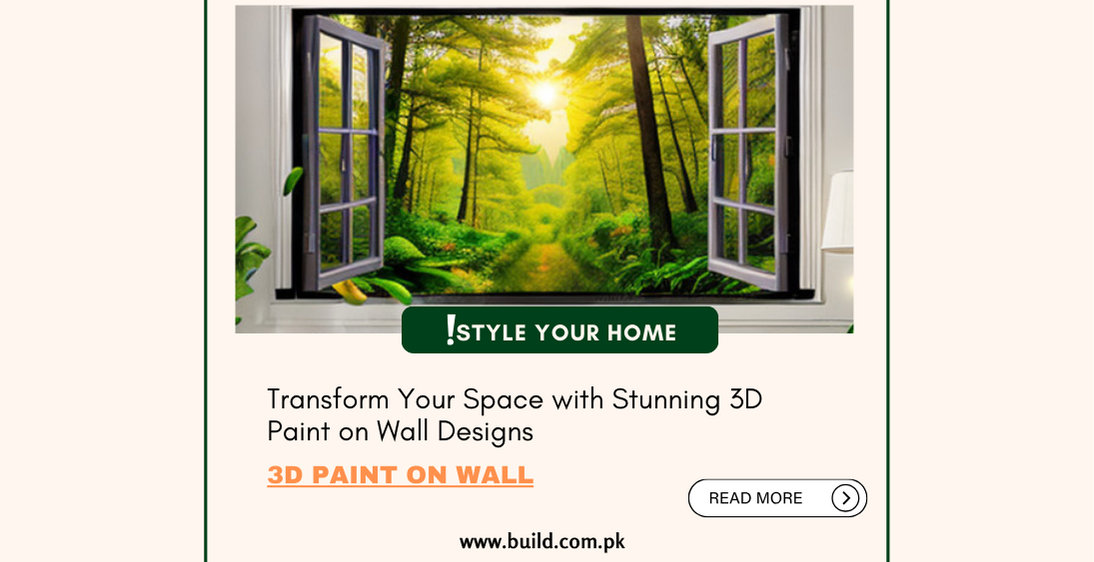Transform Your Space with Stunning 3D Paint on Wall Designs

Introduction:
In the realm of interior design, the walls of a
space serve as blank canvases waiting to be transformed into captivating works
of art. One innovative and visually striking way to elevate your walls is
through the use of 3D paint on wall designs. With the ability to create depth,
texture, and visual interest, 3D paint techniques can transform ordinary walls
into extraordinary focal points. In this comprehensive blog, we'll delve into
the world of 3D paint on wall designs, exploring the techniques, applications,
benefits, and inspiration behind this innovative approach to wall decor.
Understanding 3D Paint on Wall Designs:
3D paint on wall
designs involve the application of specialized paint techniques and materials
to create three-dimensional effects on flat surfaces. These techniques can
range from simple textured finishes to intricate murals and sculptures,
dependig on the desired aesthetic and complexity of the design. Whether you're
looking to add dimension to a small accent wall or make a bold statement in a
larger space, 3D paint techniques offer endless possibilities for creativity
and customization.

Types of 3D Paint Techniques
There are several types of 3D
paint techniques that can be used to achieve stunning effects on walls:
Textured Paint:
Textured paint is a versatile option for
adding depth and dimension to walls. This technique involves mixing additives
such as sand, silica beads, or acrylic gel with paint to create a textured
surface. Textured paint can be applied with brushes, rollers, or trowels to
achieve different effects, from subtle stippling to bold relief patterns.
Stencil Art:
Stencil art is a popular technique for creating
intricate designs and patterns on walls. This method involves using pre-cut
stencils to apply paint in specific shapes and motifs, allowing for precise and
repeatable designs. Stencil art can be combined with other techniques such as
sponging or shading to create depth and dimension.
Trompe l'Oeil:
Trompe l'oeil, which translates to
"deceive the eye" in French, is a painting technique that creates the
illusion of three-dimensional objects or scenes on flat surfaces. This
technique often involves realistic depictions of architectural elements,
landscapes, or still-life subjects, giving the impression of depth and
perspective.
Bas-Relief:
Bas-relief, also known as low relief, is a
sculptural technique that involves carving or molding three-dimensional forms
onto a flat surface. In the context of wall painting, bas-relief techniques can
be used to create raised patterns, motifs, or sculptures that protrude from the
wall surface.
Applications of 3D Paint on Wall Designs
3D paint techniques
can be applied in a variety of settings and environments, including:
Residential interiors: Add texture and visual interest to
living rooms, bedrooms, and dining areas with textured paint or stencil art.
Commercial spaces: Create eye-catching feature walls or
signage in retail stors, restaurants, and offices using trompe l'oeil or
bas-relief techniques.
Public spaces: Enhance the ambiance of public spaces such as
museums, galleries, and lobbies with bold and immersive 3D paint installations.
Benefits of 3D Paint on Wall Designs
There are several
benefits to incorporating 3D paint techniques into your wall decor:
Visual Impact: 3D paint techniques create visual interest and
focal points in a space, drawing the eye and adding depth to flat surfaces.
Customization: 3D paint techniques can be customized to suit
any design aesthetic or theme, from rustic textures to contemporary patterns.
Durability: High-quality paints and materials ensure that 3D
paint designs are durable and long-lasting, withstanding wear and tear in
high-traffic areas.
Versatility: 3D paint techniques can be applied to a variety
of surfaces, including drywall, plaster, wood, and metal, making them suitable
for virtually any interior or exterior application.
Inspiration for 3D Paint on Wall Designs
Need inspiration
for your next 3D paint project? Here are some ideas to spark your creativity:
Geometric patterns: Create modern and minimalist wall designs
with geometric shapes and patterns in contrasting colors.
Nature-inspired motifs: Bring the outdoors inside with
botanical motifs, floral patterns, or landscape scenes that add a touch of
natural beauty to your walls.
Abstract compositions: Experiment with abstract forms,
textures, and colors to create dynamic and visually engaging wall art.
Illusionary effects: Play with perspective and optical
illusions to create trompe l'oeil effects that trick the eye and captivate the
imagination.
Tips for Achieving Stunning 3D Paint on Wall Designs
To achieve
the best results with 3D paint techniques, consider the following tips:
Prepare the surface:
Ensure that the wall surface is cean,
smooth, and free of any imperfectins before applying paint. Sanding, priming,
and filling cracks or holes can help create a smooth and even base for paint
application.
Choose the right materials:
Select high-quality paints,
brushes, and tools that are suitable for the specific 3D paint technique you
plan to use. Experiment with different textures, finishes, and additives to
achieve the desired effect.
Plan the design:
Sketch out your design ideas and plan the
layout of your 3D paint project before starting. Consider factors such as
scale, proportion, and color harmony to create a cohesive and visually
appealing composition.
Practice patience:
3D paint techniques often require multiple
layers and careful attention to detail. Take your time and work methodically to
build up layers, blend colors, and refine textures until you achieve the
desired result.
Conclusion:
3D paint on wall designs offer a unique and creative way to transform ordinary walls into extraordinary works of art. Whether you're looking to add texture, depth, or visual interest to your space, 3D paint techniques provide endless possibilities for customization and creativity. By understanding the different types of techniques, applications, benefits, and inspiration behind 3D paint on wall designs, you can uneash your creativity and bring your walls to life with stunning and immersive designs that captivate the senses and elevate the ambiance of any space.









